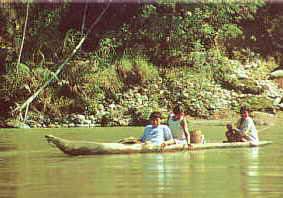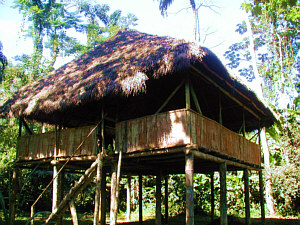|
The Quichua
are originally Highland-Indians. When the Spanish conquerors arrived the Indians moved down to the jungle to avoid slavery. They mixed with the few local natives
or dried them further out into the inland. The
 older people still tell their stories about the bloody fights with the Huaorani(aggressive Indian tribe). The Quichua brought parts
of their extensive knowledge and special plants from the highlands to the jungle, but they learned also from the local natives. They learned in the rainforest how to survive, to
recognise and to use plants as well as to hunt with curare (see page 11) and blowpipe. Nowadays the Quichua are the largest group of natives in Ecuador. older people still tell their stories about the bloody fights with the Huaorani(aggressive Indian tribe). The Quichua brought parts
of their extensive knowledge and special plants from the highlands to the jungle, but they learned also from the local natives. They learned in the rainforest how to survive, to
recognise and to use plants as well as to hunt with curare (see page 11) and blowpipe. Nowadays the Quichua are the largest group of natives in Ecuador.
The Quichua have their language, also called Quichua. Being separated for hundreds of years into highland and
lowland populations different dialects of this language have been developed. Today nearly every Quichua speaks
Spanish too, as in the schools only Spanish was allowed to be teaches in the last decades. But in the meantime there are bilingual schools again to conserve the own language. Older people, especially women, do not speak
Spanish they just can understand it reasonably.
 The houses of the Quichua
in the rainforest are always built on the edge of a river which means to them way of transport, water spring, toilet and bath as well as food spring (fish and animals coming to the water). The houses of the Quichua
in the rainforest are always built on the edge of a river which means to them way of transport, water spring, toilet and bath as well as food spring (fish and animals coming to the water).
The soils closed to rivers are the only good one in the Amazon basin, because the river sometimes floods the soil
and the carried sediments serve as fertiliser.
The Quichua could and still can adopt themselves to changing conditions of life better than other tribes in the
Amazon basin, for this reason they are more numerous than other tribes. Their population is approximately 40.000, those of the Huaorani 1400, Siona and Secoya have
already joined together and do not count more than 600 members and there are only about 400 Cofáns.
Their life is an interesting mixture between old and new. They live in houses but they still use traditional building
materials. They have adopted the 20th century with television, radio and refrigerator, but at the same time they have kept their culture based on natural powers and Shamans.
In spite of their adaptability it is hard for them nowadays as everything is changing too quickly. In the past they
have been hunters and small farmers and this has been sufficient for living. Today they are still hunters and farmers
so that they do not lack food, but cash. They have to pay for children’s education, clothes, and transport as well as for medical treatment. Moreover the Families are large and you cannot fail to notice alcohol problems.
|
